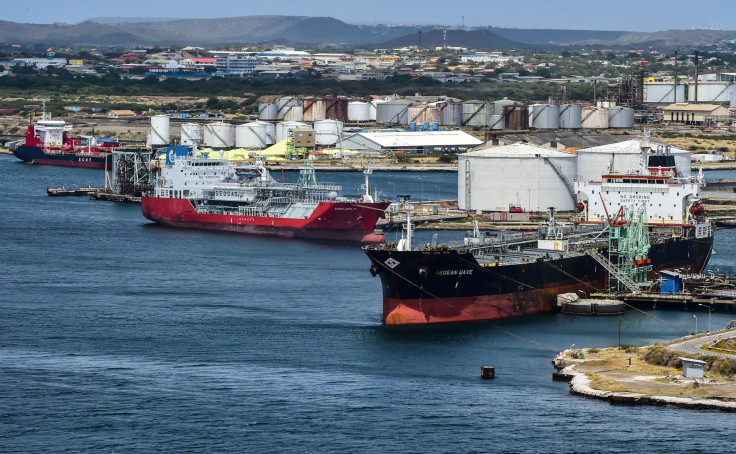Oil Prices Have Quietly Come Roaring Back This Year

The last bull market in oil abruptly ended this past fall as crude shed a full year's worth of gains in about two weeks. Overall, oil plunged 40 percent from its peak in early October, causing the U.S. oil price benchmark (WTI) to bottom out in the mid-$40s right around Christmas.
This year, however, crude prices have come roaring back, rebounding more than 20 percent from that bottom, starting a new bull market in oil. While crude has come off its highs in the last week due to renewed concerns on both the supply and demand side, WTI is currently in the mid-$50s. That's excellent news for U.S. oil producers, most of which set their budgets to cash in as long as crude was near $50 a barrel.
What's fueling oil prices this year?
The Trump administration knocked oil off its peak last fall by unexpectantly granting waivers to several key buyers of Iranian crude, enabling them to bypass the reimposed U.S. sanctions. That quickly turned the market from worrying that there wouldn't be enough oil to meet its needs to having an overabundance after OPEC hiked its output in anticipation of more powerful sanctions on Iran.
The shift in U.S. policy led OPEC to reverse course this year by reducing its output to better balance supplies with anticipated demand. OPEC's actions are starting to drain oil storage levels, which had put so much pressure on oil prices last fall.
Setting their sights lower
The plunge in oil prices toward the end of last year forced many U.S. oil producers to rethink their 2019 plans. Several reduced their capital budgets for this year to better align their investment level with anticipated cash flows, with most aiming to live within the cash they could produce at $50 a barrel. Because of that, many U.S. oil producers are poised to cash in now that oil prices are back in the mid-$50s.
Marathon Oil (NYSE:MRO) based its 2019 plans on oil averaging $50 a barrel. At that price point, the company can fund its $2.6 billion capital spending plan -- enough money to grow its U.S. oil production by 12 percent this year -- and its dividend with plenty of room to spare. Marathon has so much breathing room that it can fund its 2019 budget as well as its dividend at $45 oil, which means it's on track to produce a gusher of free cash now that oil is in the mid-$50s. Marathon currently expects to return the bulk of that money to shareholders through additional share repurchases, which sets up investors to potentially earn some high-octane total returns this year if oil keeps going higher.
Anadarko Petroleum (NYSE:APC) also used $50 oil as the baseline for its 2019 capital budget. At that price point, Anadarko Petroleum believes it can generate enough cash to fund between $4.3 billion and $4.7 billion in capital spending -- sufficient to grow its oil output 10 percent year over year -- as well as its dividend, which it has increased a jaw-dropping 500 percent in the past year. Anadarko also plans to use the cash it built up from asset sales to buy back stock and reduce debt, with it aiming to repurchase another $1.5 billion of its shares by the middle of next year -- though with oil in the mid-$50s, Anadarko is on track to produce more cash than expected this year, which could enable the oil giant to boost its buyback once again.
U.S. oil giant ConocoPhillips (NYSE:COP) used $50 oil as a rough baseline for its 2019 capital plans as well. ConocoPhillips currently expects to invest $6.1 billion on capital projects this year -- enough money to grow production per share by 8 percent -- which it can fund on the cash flows produced at $40 oil. Add in a dividend that the company increased twice last year to a $3 billion repurchase program and ConocoPhillips is on track to return 50% of the cash it produces at $50 oil to investors this year, though some of that money will come from its cash-rich balance sheet. However, with oil in the mid-$50s, ConocoPhillips is on track to produce more cash than expected this year, which could lead it to buy back even more stock than planned as it works to whittle down a cash balance that stood at $6.4 billion at the end of 2018.
Cashing in on the mid-$50s
Because these oil companies have such low production costs, they're able to set growth-focused budgets on the cash flows they can produce at sub-$50 oil prices. As a result, they're not only well insulated from another oil price crash, but positioned to cash in now that oil has rebounded back into the mid-$50s. If oil stays where it is, all three will produce more free cash than expected this year, which they'll likely return to investors through additional share repurchases that could fuel big gains in their stock prices in 2019.
This article originally appeared in The Motley Fool.
Matthew DiLallo owns shares of ConocoPhillips. The Motley Fool has no position in any of the stocks mentioned. The Motley Fool has a disclosure policy.



















